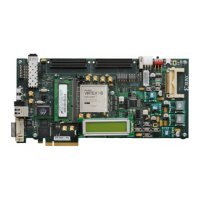240 www.xilinx.com Virtex-6 FPGA GTX Transceivers User Guide
UG366 (v2.5) January 17, 2011
Chapter 4: Receiver
Using the RX Elastic Buffer for Channel Bonding or Clock Correction
The RX elastic buffer is also used for clock correction (see RX Clock Correction) and
channel bonding (see RX Channel Bonding, page 247). Clock correction is used in cases
where PMACLK and RXUSRCLK are not frequency matched. Table 4-45 lists common
clock configurations and shows whether they require clock correction.
To use the RX elastic buffer for channel bonding or clock correction:
• Set RX_BUFFER_USE to TRUE.
• Reset the buffer whenever RXBUFSTATUS indicates an overflow or an underflow.
• The buffer can be reset using GTXRXRESET, RXRESET, or RXBUFRESET (see RX
Initialization, page 261).
RX Clock Correction
Functional Description
The RX elastic buffer has an additional benefit: it can tolerate frequency differences
between the XCLK and RXUSRCLK domains by performing clock correction. Clock
correction actively prevents the RX elastic buffer from getting too full or too empty by
deleting or replicating special idle characters in the data stream.
Figure 4-35 shows a conceptual view of clock correction.
RX_IDLE_LO_CNT 4-bit
Binary
Determines count value after which a deassertion of reset due to
RX_EN_IDLE_RESET_BUF is triggered after valid data once again present on
the RXP/RXN lines. Use the Virtex-6 FPGA GTX Transceiver Wizard default.
RX_XCLK_SEL String Selects the clock used to drive the RX parallel clock domain (XCLK).
“RXREC”: (default) XCLK domain driven by recovered clock from CDR.
When RX_OVERSAMPLE_MODE is TRUE, the recovered clock is sourced
from the oversampling block.
“RXUSR”: RXUSRCLK port drives RX parallel clock domain. Use this
mode when bypassing the RX elastic buffer.
Table 4-44: RX Elastic Buffer Attributes (Cont’d)
Attribute Type Description
Table 4-45: Common Clock Configurations
Needs Clock Correction?
Synchronous System (both sides use same physical oscillator for
REFCLK)
No
Separate Reference Clocks, RX uses recovered clock No
Separate Reference Clocks, RX uses local clock Yes

